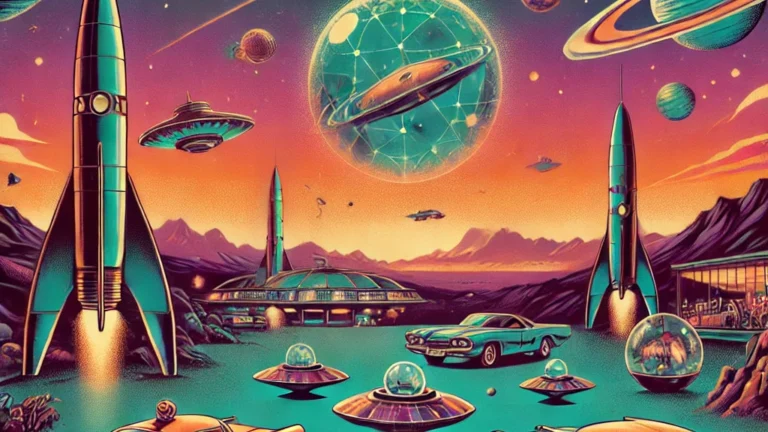Some of the most famous science fiction movies have come out of the 1960s, yet a lot of amazing films have gone unnoticed since they were overshadowed by box office hits like Planet of the Apes and 2001: A Space Odyssey. This period saw a change in science fiction, with works addressing space travel, nuclear phobias, and the future of humanity—often with innovative visual effects and provocative topics. A revisit of these underappreciated science fiction movies from the 1960s is recommended due to their innovative and ambitious nature. They include:
1960’s The Time Machine
George Pal is the director of The Time Machine, an action-packed visual extravaganza based on the novel by H.G. Wells. As Rod Taylor’s lead character meets the futuristic Eloi and their terrifying predators, the Morlocks, the movie delves into themes of social evolution and survival. Even though it leaves out some of the esoteric components of the book, the adaptation is nonetheless thrilling and gorgeous to look at.
1960’s Village of the Damned
The Midwich Cuckoos, a scary version of John Wyndham’s novel, centers on a small village where women inexplicably give birth to children that resemble aliens and possess terrifying powers. The film explores themes of domination, invasion, and humanity’s fragility while evoking a sense of dread and anxiety.
The Day the World Burned (1961)
This bleak science fiction thriller, set against the backdrop of the Cold War, examines the worldwide fallout from mishandled nuclear testing. The movie deftly strikes a balance between character development and realistic images of a society on the verge of annihilation when Earth’s orbit is changed, endangering the planet’s future.
Fear in the Zero Year (1962)
In this classic post-apocalyptic survivalist movie, Ray Milland’s character has to work quickly to save his family after atomic bombs devastate large cities. The film provides a devastating investigation of humanity’s plunge into anarchy after social collapse, notwithstanding financial constraints.
1963’s The Day of the Triffids
The Day of the Triffids, an adaptation of John Wyndham’s story, paints a terrifying picture of an alien plant species taking over a blinded Earth. The movie conveys the fear of an extraterrestrial invasion that turns the world upside down, even though it is not totally true to the book.
1963’s X: The Man with the X-Ray Eyes
Ray Milland portrays a scientist who develops x-ray vision and eventually goes insane in Roger Corman’s existential science fiction. The movie explores the perils of human power and curiosity, leading to an eerily melancholic ending.
Ikarie XB-1 (1963)
Based on a Stanislaw Lem novel, this gem from Czechoslovakia is a wonderful example of intelligent, thought-provoking science fiction. It explores themes of existential dread and loneliness while following a deep-space mission. 2001: A Space Odyssey and other later space exploration masterpieces were probably influenced by this significant movie.
The Damned, released in 1963
The Damned, directed by Joseph Losey, begins as a drama about teenage criminality but soon devolves into sci-fi horror. A middle-aged traveler discovers youngsters who are maybe survivors of a nuclear war and are being held hostage by the government. The children are radioactive in secret. The film delivers a scathing critique of authority and scientific ethics through its dark, experimental plot.
1964’s The Last Man on Earth
The most accurate rendition of Richard Matheson’s I Am Legend is still the original, starring Vincent Price. The film’s exploration of isolation and ominous, post-apocalyptic atmosphere have influenced later works, such as Night of the Living Dead, despite being written off as low-budget at the time.
The 1964 film Robinson Crusoe on Mars
This science fiction movie, which tells the story of a stranded astronaut on Mars, is a reworking of Robinson Crusoe. He is up against hostile alien troops and a difficult environment with few resources. Robinson Crusoe on Mars is a captivating journey that combines fantasy and science fiction, despite the corny title.
The Tenth Casualty (1965)
The dystopian future shown in this Italian film, directed by Elio Petri, sees people competing in a televised death battle for fame and fortune. The idea foreshadows movies such as The Running Man and The Hunger Games, which combine action and comedy to make a statement against violence in the media.
1965’s Planet of the Vampires
Mario Bava, the master of Italian horror, directed this sci-fi/horror film, which served as a forerunner to Alien. A dark force on a barren planet takes control of a spaceship’s crew. Bava creates an unsettling, fantastical space adventure that is still influencing people today with his use of atmospheric directing and creative imagery.
Seconds (1966)
Seconds by John Frankenheimer is a masterwork of psychological science fiction. In the film, Rock Hudson plays a man who gets a new identity and life through surgery, only to become imprisoned in existential misery. This eerie film examines how society is fixated with youth and self-reinvention.
For aficionados of the genre, these films are a must-watch because they pushed the limits of what science fiction could achieve in terms of ideas, storytelling, and spectacular effects. Even though they didn’t get the credit they deserved at the time, many contemporary science fiction masterpieces nevertheless bear their impact.
